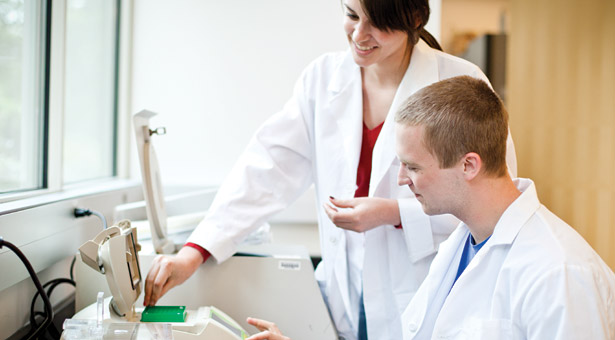Science & Technology Research and Discoveries
Published Before Prom
Through SPU Program, High School Students Do Real Research
By Hope McPherson (hmcpherson@spu.edu)

Through GENI, undergraduates, high school students, and scientists do genetics research together. In one of SPU’s Science Building labs, Princeton University junior Danielle Vellon and SPU senior Chris Welter prepare a PCR reaction to amplify a piece of DNA.
Seattle Pacific University has long encouraged its undergraduate students to do original, hands-on
research. Now, through the Genomics Education National Initiative (GENI), Seattle Pacific is getting high school students in on the action.
“By doing research that goes beyond mixing A and B and getting C, high school students get excited,” says Associate Professor of Biology Derek Wood, adding that the results will eventually be published in a scientific journal. “The students will be authors on these papers. They’re not just doing work in class; they are making valuable contributions to science.”
In development for 10 years, GENI and its creators (SPU and the Great Lakes Bioenergy Research Center at the University of Wisconsin) were awarded a $251,941 grant from the Monsanto Fund, the philanthropic arm of the Monsanto Company that seeks to improve the quality of science education. Seattle Pacific received $237,763 to develop the course materials; the University of Wisconsin received $14,178 to help oversee the project.
Through GENI, high school students and teachers can participate in advanced genomic research from their own classrooms and school labs. Currently aimed at schools in Washington,Wisconsin, Arizona, and Ohio, GENI allows high school science classes to choose between ongoing studies that allow students to participate in a genomesequencing project. Students identify and arrange the pieces of a specific genome, use their computers to predict gene function, and then experimentally validate their results. The projects can have far-reaching effects in understanding the genome, or “instruction manual” of a cell.
This information, explains Wood, can help create better ways to fight crop disease or to develop crops that have specific, desired traits. “At a more basic level, students gain an understanding of the mechanisms and value behind genome data.”
This is high school science? Yes, it’s valuable for university researchers to ask high schoolers to take part in this research, says Wood. For one, they’re replicating the experiment — which helps strengthen any conclusions drawn from the research. And it’s a valuable teaching tool.
“Students move from learning the material to understanding the big picture — which can catapult them into a career in the biological sciences, or whatever they choose,” explains Katey Houmiel, an SPU senior scientist and the GENI project director.
When a class begins to participate, Houmiel sends the materials they’ll need, including labeled tubes and electronics. Students also receive access to geni-science.org, where they can input results and find additional support.
“We can also visit classrooms if they are close geographically, or use online communication tools like Skype,” adds Wood.
For the past two summers, Wood, Houmiel, and SPU undergraduate assistants have also welcomed teachers and students to campus for a weeklong Summer Research Institute. In 2010, students came to work on Agrobacterium rhizogenes A4 genome sequencing project; in 2011, teachers were invited to come and do the same.
“We gave teachers experience with the module,” says Wood. “When they go back to their classrooms, our website and materials will support them so they can continue the project off-site.”
“By providing a way for the students to do original research, and connecting them to university researchers, students see that this work is both interesting and approachable,” explains Steven Slater, scientific programs manager at the Great Lakes Bioenergy Research Center. “They see it as an exciting way to spend time, and that they can really contribute to the scientific enterprise.”
In the next several years, the number of projects offered through GENI is expected to grow. “I would expect to have between 30 and 50 projects, minimum, in 10 years,” says Wood, adding that new projects will be added when any of them are completed. “I hope to see this model extended to many other disciplines including psychology, languages, sociology, and so forth. There is a lot of potential for this collaborative interface in any type of research with students.”
